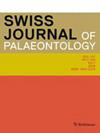关于在泥岩中进行古生物挖掘和取样的报告:一些指导原则
IF 3
2区 地球科学
Q1 PALEONTOLOGY
引用次数: 0
摘要
世界上 60% 以上的沉积岩都是泥岩(Potter 等人,1980 年;Schieber,1998 年;Potter,2003 年;此处使用泥岩一词而非泥岩,因为后者被用来描述石灰岩的质地;Dunham,1962 年)。从古生物学的角度来看,与砂岩和石灰岩相比,泥岩的取样严重不足。其主要原因是泥岩在地表暴露时会腐烂成小碎屑,这些碎屑在日晒/高温和雨水的作用下会形成笨拙的泥浆。泥岩的腐烂同时也破坏了所有不耐久的大型化石。这包括具有霰石质或精致钙质外壳的化石,除非它们被保存为黄铁矿或内部钙质模具,或保存在钙质凝块中。因此,大部分化石都没有记录在地表出露的化石中。此外,泥岩的沉积学研究也受到阻碍,因为 (i) 压实使沉积结构难以辨认,(ii) 制作泥岩的良好薄片极其困难。对于微古生物学研究来说,富含有机物质的泥岩尤其难以处理。用沸水、碳酸钠溶液或过氧化氢 H2O2 进行标准处理通常无法溶解大部分沉积物,因此细小部分(在泥岩中我们通常需要 63 微米部分)主要由粘土颗粒聚集而成。然而,有一些方法可以溶解这些聚集体。否则,采集微化石将变得非常费力。本文概述了在泥岩中成功开展古生物工作的一些指导原则。这些都是基于作者的个人经验。瑞士/欧洲侏罗纪泥岩中的实例表明,这种发掘工作是非常有益的。本文章由计算机程序翻译,如有差异,请以英文原文为准。
A report on palaeontological excavations and sampling in mudrocks: some guidelines
More than 60% of the world’s sedimentary rocks are mudrocks (Potter et al., 1980; Schieber, 1998; Potter, 2003; the term mudrock is favored here over mudstone because the latter term was used to characterize a limestone texture; Dunham, 1962). From a palaeontological perspective these are, compared to sandstones and limestones, heavily undersampled. The main reason for this is that mudrocks decay in surface exposures to small chips, which develop with sun/heat and rain into an awkward pulp. The decay of the mudstone concomitantly destroys all macrofossils which are not durable. This comprises fossils with an aragonitic or delicate calcitic shell unless they are preserved as pyritic or internal calcitic molds or preserved within calcareous concretions. Therefore, most of the fossils are not recorded in surface exposures. In addition, sedimentologic investigations of mudrocks are hampered because (i) compaction makes sedimentary structures hardly recognizableand (ii) good thin sections of mudrocks are exceedingly difficult to manufacture. For micropalaeontological investigations, mudrocks rich in organic material are especially difficult to process. Standard treatments with boiling water, sodium carbonate solution, or peroxide H2O2 generally fail to dissolve much of the sediment so that the fine fraction (and in mudrocks we usually need the 63μm-fraction) largely consists of clay particle aggregates. Yet there are methods to dissolve these aggregates. Otherwise, picking the microfossils would become extremely laborious. In this paper, some guidelines for successful palaeontological work in mudrocks are outlined. These are based on the author’s personal experience. Examples from Jurassic mudrocks of Switzerland/Europe show that such excavations can be very rewarding.
求助全文
通过发布文献求助,成功后即可免费获取论文全文。
去求助
来源期刊

Swiss Journal of Palaeontology
Earth and Planetary Sciences-Paleontology
CiteScore
4.30
自引率
16.70%
发文量
17
审稿时长
4 weeks
期刊介绍:
The Swiss Journal of Palaeontology publishes original research and review articles of interest to the international community in the fields of palaeontology, taxonomy and systematics, while recognising at the same time the importance of documenting high-quality palaeontological data in a regional context. Palaeobiology in combination with alpha taxonomy is a core topic of the journal.
Submitted papers should have an appeal as wide as possible, directed towards an international readership. Contributions should not have been simultaneously submitted elsewhere, and the overlap of content between related articles should be minimal. Duplications of text and the use of previously published illustrations without adequate citation are unacceptable. If a manuscript has two or more authors, both or all have to sign to confirm they all were involved in the work and have agreed to its submission. The preferred manuscript language is UK English, but consistently used US English is also acceptable. We encourage the publication of proceedings of international meetings as well as special thematic issues. Short contributions and book reviews are also accepted.
An international editorial team as well as guest editors guarantee that the thematic issues as well as all articles in regular issues are peer-reviewed and meet the highest standards.
 求助内容:
求助内容: 应助结果提醒方式:
应助结果提醒方式:


